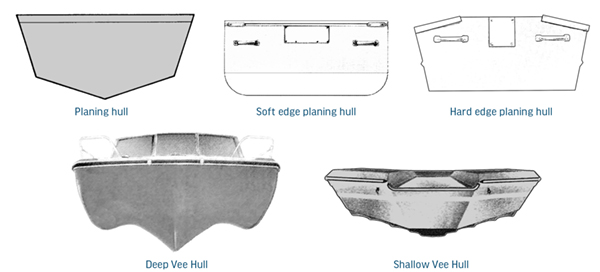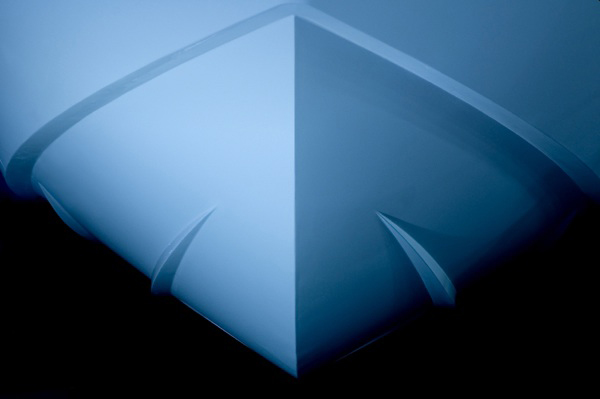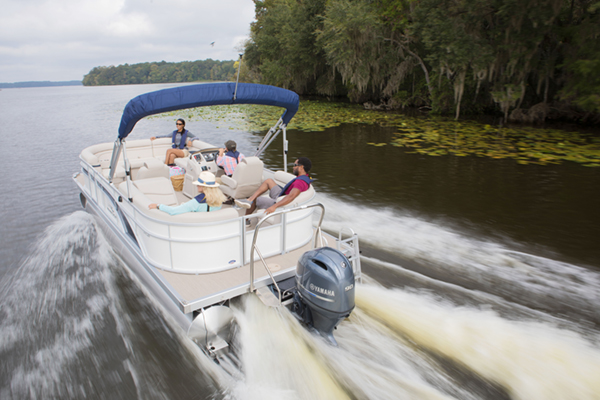Idling through the marina or cruising across the lake, we’ve all seen boats with snazzy paint jobs and condo-like luxuries that tempt us to covet our neighbor’s vessel. Hundreds of boats look cool above the rubrail, but it’s what you can’t see – the hull design – that determines how the craft handles the realities of open water.

There are countless hull designs; however, most are variations of three basic styles: displacement hulls, semi-displacement hulls, and planing hulls.
Planing hulls are the primary focus of our discussion, simply because the majority of recreational power boaters use boats with planing hull designs to embrace the boating lifestyle. To keep things equitable, we’ll present a brief overview of displacement and semidisplacement hulls before moving on to planing hulls.
Displacement Hulls
Most ships, commercial fishing boats, and recreational trawlers are round bottom, displacement hulls that literally push (displace) the water, allowing the boat to travel forward. These vessels tend to ride low in the water, and aren’t particularly fast. However, the displacement hull design can transport large volumes of cargo (due to the deep hull), and the round hull can be more sea-kindly than other vessels.

Semi-Displacement Hulls
Combining many of the traits of a displacement hull with a few planing hull features, a semi-displacement hull operates in displacement mode (pushing through the water) much of the time. Significantly increasing the engine speed causes the boat’s bow to rise out of the water a bit, almost getting on plane, but not quite – and the handful of additional mph aren’t proportionate to the same amount of throttle in a planing hull.
Planing Hulls
At idle/no-wake speeds, planing hulls act just like displacement hulls – slowly plowing the water aside to make headway. After leaving the go-slow zone, advancing the throttle on your Yamaha outboard makes the planing hull go faster, lifting the boat, allowing it to zip over the waves, rather than slogging through them.
Unlike a displacement hull, you’re not likely to find rounded areas on the running surface; conversely, nearly all planing hulls use flat sides that meet the bottom at a definitive corner (chine), with the sides and bottom terminating at a broad transom.
Flat bottom boats are the simplest of the planing hulls, frequently use a tiller steer Yamaha outboard, and are a good choice for shallow, protected waterways, since the flat hull style doesn’t have much draft. The hull sides can meet the bottom at a sharp corner angle (hard chine), or the bottom and sides may connect with a slight radius (soft chine) The flat bottom boat’s bow can be squared off (the flat bottom turned upwards to the bow) a design often associated with Jon boats, or trimmed for a V-type forward section. On the other hand, the bottom may have multiple compound radii to form a V-shaped bow – common practice on small utility boats.
V-hull bottoms are by far the most popular pleasure boat hull on the water, due in no small part that the V-hull can be an outstanding rough water boat, and fast as well. Looking at the boat’s transom, the angle of the V-bottom – the deadrise – is obvious. When engineers are seeking certain performance characteristics in anew boat design, the deadrise angle is a major factor.
For example, an offshore racer or a bluewater angler will probably opt for a 24-degree deadrise (pretty much 24-degrees from transom forward) to handle ultra-high speeds in any sea conditions. This is a proven solution for the extreme speed seeker/competitive long distance angler. Underway, the sharp deadrise will get the job done, but at rest, the true super deep-V tends to rock from side-to-side in a most unpleasant manner.
Several decades ago, enterprising boat builders decided to use a V for the center section of the hull, added (for the lack of a better term) miniature V-shaped outriggers/sponsons outboard and slightly higher than the center V to create the infamous tri-hull configuration. The thinking was that the center V would make the boat fast, and the sponsons would stabilize the boat when it was stationary.
This is where modified V-hulls enter the picture. Consumers don’t like boats that roll gunnel-to-gunnel when at anchor or drifting lazily across the lake. But these same people want a boat that’s reasonably fast while remaining smoothriding. To address these requirements, the naval architect starts with a moderate (15-degree) deadrise at the transom that twists into a much more aggressive deadrise angle moving forward along the bottom of the hull. The shallow deadrise daft ought to help the boat plane quickly, attain respectable speeds, and steady the craft at rest. At the bow, the sharp entry should slice the chop, and may help rough water handling. Most middle-of-the road family boats are a type of modified V-hull.
At the other end of the spectrum are the highly modified V-hull bass boats. These race boats with rod holders use the latest in hull design technology to squeeze every drop of speed from the boat/engine setup, while making the deck layout an uncluttered, practical fishing platform. For the pro angler, the boat is just a tool to get to the fish – and back to the weigh-in–as fast as possible.

Pontoons
Pontoon boats can be displacement, semi-displacement, or planing hulls – it all depends on the boat’s intended purpose, the manufacturer’s design, and how much horsepower is on the transom.
Conclusions
Boat hull designs seem to be continually evolving, due to market fluctuations, advances in boat construction technology, and the ongoing quest for improvements in fuel efficiency.
Hull design is really an amazing topic, and influences a boat’s performance and behaviors more than any other aspect of the vessel.
Back to Blue Life

There are countless hull designs; however, most are variations of three basic styles: displacement hulls, semi-displacement hulls, and planing hulls.
Planing hulls are the primary focus of our discussion, simply because the majority of recreational power boaters use boats with planing hull designs to embrace the boating lifestyle. To keep things equitable, we’ll present a brief overview of displacement and semidisplacement hulls before moving on to planing hulls.
Displacement Hulls
Most ships, commercial fishing boats, and recreational trawlers are round bottom, displacement hulls that literally push (displace) the water, allowing the boat to travel forward. These vessels tend to ride low in the water, and aren’t particularly fast. However, the displacement hull design can transport large volumes of cargo (due to the deep hull), and the round hull can be more sea-kindly than other vessels.

Semi-Displacement Hulls
Combining many of the traits of a displacement hull with a few planing hull features, a semi-displacement hull operates in displacement mode (pushing through the water) much of the time. Significantly increasing the engine speed causes the boat’s bow to rise out of the water a bit, almost getting on plane, but not quite – and the handful of additional mph aren’t proportionate to the same amount of throttle in a planing hull.
Planing Hulls
At idle/no-wake speeds, planing hulls act just like displacement hulls – slowly plowing the water aside to make headway. After leaving the go-slow zone, advancing the throttle on your Yamaha outboard makes the planing hull go faster, lifting the boat, allowing it to zip over the waves, rather than slogging through them.
Unlike a displacement hull, you’re not likely to find rounded areas on the running surface; conversely, nearly all planing hulls use flat sides that meet the bottom at a definitive corner (chine), with the sides and bottom terminating at a broad transom.
Flat bottom boats are the simplest of the planing hulls, frequently use a tiller steer Yamaha outboard, and are a good choice for shallow, protected waterways, since the flat hull style doesn’t have much draft. The hull sides can meet the bottom at a sharp corner angle (hard chine), or the bottom and sides may connect with a slight radius (soft chine) The flat bottom boat’s bow can be squared off (the flat bottom turned upwards to the bow) a design often associated with Jon boats, or trimmed for a V-type forward section. On the other hand, the bottom may have multiple compound radii to form a V-shaped bow – common practice on small utility boats.
V-hull bottoms are by far the most popular pleasure boat hull on the water, due in no small part that the V-hull can be an outstanding rough water boat, and fast as well. Looking at the boat’s transom, the angle of the V-bottom – the deadrise – is obvious. When engineers are seeking certain performance characteristics in anew boat design, the deadrise angle is a major factor.
For example, an offshore racer or a bluewater angler will probably opt for a 24-degree deadrise (pretty much 24-degrees from transom forward) to handle ultra-high speeds in any sea conditions. This is a proven solution for the extreme speed seeker/competitive long distance angler. Underway, the sharp deadrise will get the job done, but at rest, the true super deep-V tends to rock from side-to-side in a most unpleasant manner.
Several decades ago, enterprising boat builders decided to use a V for the center section of the hull, added (for the lack of a better term) miniature V-shaped outriggers/sponsons outboard and slightly higher than the center V to create the infamous tri-hull configuration. The thinking was that the center V would make the boat fast, and the sponsons would stabilize the boat when it was stationary.
This is where modified V-hulls enter the picture. Consumers don’t like boats that roll gunnel-to-gunnel when at anchor or drifting lazily across the lake. But these same people want a boat that’s reasonably fast while remaining smoothriding. To address these requirements, the naval architect starts with a moderate (15-degree) deadrise at the transom that twists into a much more aggressive deadrise angle moving forward along the bottom of the hull. The shallow deadrise daft ought to help the boat plane quickly, attain respectable speeds, and steady the craft at rest. At the bow, the sharp entry should slice the chop, and may help rough water handling. Most middle-of-the road family boats are a type of modified V-hull.
At the other end of the spectrum are the highly modified V-hull bass boats. These race boats with rod holders use the latest in hull design technology to squeeze every drop of speed from the boat/engine setup, while making the deck layout an uncluttered, practical fishing platform. For the pro angler, the boat is just a tool to get to the fish – and back to the weigh-in–as fast as possible.

Pontoons
Pontoon boats can be displacement, semi-displacement, or planing hulls – it all depends on the boat’s intended purpose, the manufacturer’s design, and how much horsepower is on the transom.
Conclusions
Boat hull designs seem to be continually evolving, due to market fluctuations, advances in boat construction technology, and the ongoing quest for improvements in fuel efficiency.
Hull design is really an amazing topic, and influences a boat’s performance and behaviors more than any other aspect of the vessel.
Back to Blue Life
